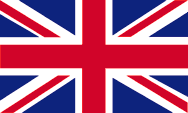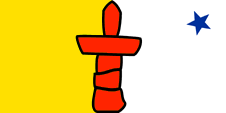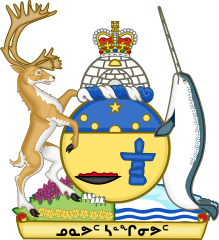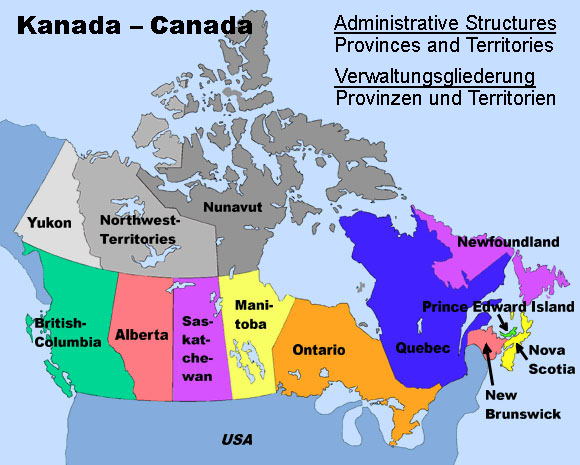mobile Ansicht, to the English Version tap the flag


• Flagge
• Bedeutung/Ursprung der Flagge
• Wappen
• Bedeutung/Ursprung des Wappens
• Landkarte
• Zahlen und Fakten
• Geschichte
• Ursprung des Landesnamens

Flagge des Nunavut-Territoriums,
Seitenverhältnis = 1:2,
Quelle, nach: Wikipedia (D)






Die Flagge von Nunavut wurde am 01.04.1999 erstmals gehisst. Sie ist vertikal in Gelb (Gold) und Weiß (Silber) geteilt. Gelb steht für den Reichtum an Bodenschätzen und Weiß für Eis und Schnee. In der Mitte zwischen beiden Farben ein roter "inukshuk", eine Steinsäule die eine Person darstellt, und von den Inuit als Wegweiser oder auch als Meilenstein verwendet wird. In der rechten Oberecke des weißen Feldes befindet sich ein blauer fünfzackiger Stern, der Nordstern. Die fünf Zacken stehen für die fünf idigenen nordischen Völker der Eskimo: Inuit (Kanada), Inuvialuit (Kanada), Kalaallit (Grönland), Inupiaq (Alaska) und Jupikyt (Russland).
Quelle: Wikipedia (D)


Wappen von Nunavut,
Quelle: Di (they-them), based on blazon provided by the
Canadian Heraldic Authority, CC BY-SA 4.0, via Wikimedia Commons

Das Wappen des kanadischen Nunavut-Territoriums wurde anlässlich der Gründung des Territoriums von Generalgouverneur Roméo LeBlanc genehmigt. Es ist gewiss das erste Wappen in der Welt, das Symbole der Inuit in ein herkömmliches Wappen einbindet. Das Schild ist kreisrund und ist horizontal blau und gelb zweigeteilt. Die etwas kleinere obere Hälfte ist blau und zeigt den Nordstern, die größere untere Hälfte ist golden und steht für den Reichtum des Landes an Mineralien oder auch für die Mitternachtssonne, und sie enthält die Abbildungen eines "qulliq", einer Steinlampe, welche für die Wärme der Häuser und der Gemeinschaft steht, und eines "inukshuk", einer Steinsäule die eine Person darstellt, und von den Inuit als Wegweiser oder auch als Meilenstein verwendet wird. Die Wappenkrone zeigt ein Iglu. Es steht für das traditionelle Leben, das Weiterbestehen und die Regierung von Nunavut. Auf dem Iglu die britische Krone. Sie steht für die königliche Macht. Schildhalter sind ein Karibu (Rentier) und ein Narwal. Sie repräsentieren den Lebensunterhalt und die natürlichen Ressourcen des Landes zu Wasser und an Land. Sie stehen auf einem Postament, rechts mit arktischem Mohn, Zwergfeuerkraut und arktischer Heide bewachsen, und links einen Eisberg im Wasser zeigend. Auf der Vorderseite des Postamentes in Inuktitut, einer der Sprachen der Inuit das Landesmotto "Nunavut Sanginivut" → "Nunavut unsere Kraft"
Quelle:
Wikipedia (D)


Landkarte/Map:
Volker Preuß

Fläche: 1.877.778 km²
Einwohner: 39.797 (2016), davon 85% Eskimos (Inuit)
Bevölkerungsdichte: 0,02 Ew./km²
Hauptstadt: Iqaluit (bis 1986 Frobisher Bay), 7.740 Ew. (2016)
Amtssprachen: Englisch, Französisch, Eskimoisch (Inuktitut und Inuinnaqtun)
Währung: kanadische Währung
Zeitzone: MEZ – 5 bis – 8 h
Quelle:
Wikipedia (D)

ca. 10.000–4.000 Jahre v.Chr. · Besiedlung durch Vorfahren der Eskimos
ca. 1000 · Normannen erreichen die kanadische Ostküste
1576 · Martin Frobisher, ein englischer Seefahrer, entdeckt die Küste von Baffin Island
17. Jahrhundert · Expeditionen unter Henry Hudson, William Baffin und Robert Bylot
1670 · englische Pelzhändler gründen die Hudson's Bay Company (HBC), die HBC kolonisiert in der Folgezeit ganz Kanada zwischen Neufrankreich den Rocky Mountains, Labrador und dem Nordrand der Hudson-Bucht
1869 · die Hudson's Bay Company (HBC) überträgt alle ihre territorialen und Hoheitsrechte an das britische Dominion Kanada
1870 · Bildung der Nordwest-Territorien aus den Gebieten der HBC, Rupertsland und Nordwestliches Territorium, die Arktischen Inseln kommen unter direkte britische Verwaltung
1870 · Bildung der Provinz Manitoba durch Herauslösung aus den Nordwest-Territorien
1876 · Bildung des Keewatin-Territoriums durch Herauslösung aus den Nordwest-Territorien
1880 · Eingliederung der Arktischen Inseln in die Nordwest-Territorien
1881 · Vergrößerung der Provinz Manitoba durch Angliederung von Gebieten des Keewatin-Territoriums
1883 · Bildung der Territorien Alberta, Athabaska, Saskatchewan und Assiniboia durch Herauslösung aus den Nordwest-Territorien
1895 · Bildung des Franklin-Distrikts und des Mackenzie-Distrikts innerhalb der Nordwest-Territorien, und des Yukon-Territoriums im äußersten Nordwesten durch Herauslösung aus den Nordwest-Territorien
1905 · Eingliederung von Keewatin als Distrikt in die Nordwest-Territorien
1912 · nochmalige Vergrößerung der Provinz Manitoba durch Angliederung der südlichen Gebiete des Keewatin-Distrikts
1925 · Ausdehnung der Grenzen der Nordwest-Territorien als Sektorengrenzen bis hin zum Nordpol
01.04.1999 · Bildung des Eskimo Nunavut-Territoriums mit einer eigenen Regionalregierung durch Ausgliederung aus den Nordwest-Territorien auf Kosten des Keewatin-Distrikts, fast des gesamten Franklin-Distrikts und großer Teile des Mackenzie-Distrikts
Quelle:
Atlas zur Geschichte,
World Statesmen,
Wikipedia (D),
Discovery '97

Der Name des Territoriums stamm aus der Sprache der Eskimo (Innuit) und heißt übersetzt "unser Land".
Quelle:
Wikipedia (D)


![]()






